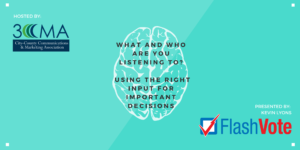
3CMA, the City-County Communications & Marketing Association, earned rave reviews for a recent webinar on good and bad data. The audience learned how the quality of public input makes a big difference on their agency’s ability to make good decisions. One attendee said, “I wished this webinar could have gone on for another hour! Great information from start to finish.”
The recording is now available for free in 3- to 12-minute segments for anyone who missed it.
“What and Who Are You Listening To? Using the Right Input for Important Decisions,” was presented by FlashVote Co-Founder and CEO Kevin Lyons, based on the highly-rated class he taught to Certified Public Communicator students at Texas Christian University in January 2020.
Lyons breaks the talk into three parts:
- Part 1 introduces basic data problems and misunderstandings by examining COVID-19 data.
- Part 2 explains public input needs and challenges with real examples ranging from racism in the South during the 1970s to recent lockdown protests and police protests.
- Part 3 looks at ways public agencies can get good input and avoid input that is misleading.
The webinar opens by introducing the concept of “working wiser”–on the right things–instead of just working smarter or harder on things that may not be as valuable. Data is the key to working wiser but there are challenges like self-selection, over-aggregation and missing context. Bad data can have costly consequences, particularly for governments, whose success depends on decisions that serve the needs and wants of their whole communities.
Self-selected samples may not be obvious, but they give you data that is unrepresentative and unreliable. Take Stanford’s April 17, 2020 study on those with COVID-19 antibodies in Santa Clara County, an example Lyons raises. Stanford researchers used Facebook ads to recruit test volunteers, an approach that encouraged self selection rather than representative sampling. This attracted criticism from statisticians around the country.
Lyons explained how data might get lumped together or “over” aggregated in ways that can hide the most useful information. When it comes to the coronavirus, older people have 150 times the risk of younger people. Talking about one overall mortality risk obscures that the oldest age groups (80+) may need extreme protections while 25 and under may need few, if any special precautions.
“Jurisdictions, unfortunately, missed this data and context and it cost lives,” Lyons said during his presentation, noting that the most vulnerable were underprotected, as when some governments sent people recovering from the coronavirus to nursing homes, an error that may have cost senior lives. Almost 42 percent of deaths from COVID-19 in the United States were in nursing homes–even though only 0.6 percent of the population lives there. In Canada, nursing home residents are 1.2 percent of the population but account for 81 percent of coronavirus deaths.
Lyons then spent the bulk of the webinar discussing how local governments face similar data challenges when it comes to getting representative community input. Mixing real examples and intuitive explanations, he shows how the data from online and in-person engagement is usually very different from the representative data that agencies actually need. The webinar closes with a discussion of how to get good data and avoid bad data, including some simple checklists and tricks people can use right away to help ignore the noise.
“The way you get your data makes a big difference to the picture it paints of what’s really going on,” said Lyons.
And what if you do it the wrong way? “You can get horrible data that can actually cost you millions.”
Those interested in using the right data to inform decisions for their community and avoid big mistakes can learn more by watching the 3CMA webinar.
